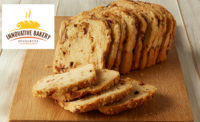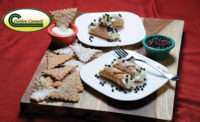New formulation strategies for bakery snacks
Developers of bakery snacks seek differentiation to drive growth




Bakery snacks saw a relatively flat year per IRI, Chicago, with 0.16 percent growth to $3.4 billion. Grupo Bimbo far outperformed the category average, though, with growth of 14.48 percent to $249.4 million.
The pastry and doughnuts category, encompassing pastries, Danishes, coffee cakes, doughnuts and muffins, likewise was flat, up only 0.91 percent to $5.1 billion. The muffins segment saw the most growth, up 8.50 percent to $1.2 billion. Private label leads muffins, with growth of 14.22 percent to $402.3 million. Grupo Bimbo also saw healthy growth in muffins, up 15.44 percent to $394.6 million,
Trend-spotting
“We’ve noticed a growing trend around internationally inspired bakery snacks like French brioche, eclairs and croissants, as well as Chinese bao, Mexican concha and churros, etc.,” says Tim Boote, St Pierre, marketing director, Manchester, England. “We’re also seeing a lot more creativity within the space. We’ve noticed classic desserts like doughnuts, croissants and eclairs are getting a modern makeover with exotic flavors and ingredients.”
The bakery mashup is another great example of creativity within the space, notes Boote. “The cronut really started this trend, then we saw the cretzel (the pretzel croissant) and the duffin (the doughnut muffin), among others. Some retailers have even started branding their own bakery hybrids, like the cinnamon croissant loaf.” He notes that the idea of the bakery mashup has inspired many St Pierre products, like the Brioche Popovers. “We’ve been hard at work creating the next European bakery hybrid and are excited to debut it later this year.”
Convenience is a huge driver across all food categories, particularly for Gen Z. “They’re replacing meals with more snacks throughout the day,” notes Boote. “For this reason, we see snackable and craveable handheld items like muffins, Danish, croissants, scones, biscuits, bagels and rolls experiencing more growth.” In response, St Pierre will launch a new Food to Go line later this year, consisting of individually wrapped European bakery snacks, including cake bars.
From an ingredient perspective, clean label and sugar-reduction remain key trends to watch in the bakery space, notes Matt Gennrich, senior food technologist, R&D bakery applications, Cargill, Minneapolis. “While consumers may say, ‘Don’t mess with my treats,’ muffins, pastries and even doughnuts aren’t immune to clean label desires. Consumers are looking for shorter ingredient statements, with names they recognize. We’re also seeing more bakeries request organic, non-GMO and allergen-free ingredient options.”
Gennrich notes that Cargill’s deoiled canola lecithin reflects those trends. “Bakers recognize lecithin is a proven emulsifier, offering dough conditioning, moisture retention, fat extension and even aeration benefits in pastries and laminated doughs. In addition to its functional benefits, it fits today’s label-friendly requirements. It’s a non-GMO, plant-sourced ingredient that may be used in organic products and does not have to be declared as a major food allergen.”
Incrementally better for you
Some of the top trends occurring within muffins and snack cakes include gluten-free, non-GMO, clean label and vegan, says Jennifer Stephens, vice president of marketing, Fiberstar, Inc., River Falls, WI. “Manufacturers are creating new gluten-free products and/or improving the texture and quality of current products.” This includes improvements to texture and nutrition. She suggests using functional natural citrus fibers that have both insoluble and soluble fiber content. “Not only does the citrus fiber contribute fiber to the nutritional label, but it also improves the texture. The high water-holding content and natural emulsification properties creates products that stay fresh, which improves quality over time.”
Due to the plant-based foods movement, many bakers are coming on line with vegan offerings, notes Stephens. This means replacing core bakery staples like eggs and butter. Bakers continue to look for animal-free alternatives while maintaining the quality of the food. Many gluten-free developers tend to look toward reducing or eliminating allergens within the product. “As a result, formulators look for natural alternatives to wheat, eggs, soy and dairy.”
Sugar reduction is also poised to have a greater effect, suggests Gennrich. “Effective solutions to replace bulk, such as combinations of erythritol and chicory root fiber, and consumer-friendly options for enhancing sweetness, such as stevia leaf extracts and steviol glycosides, will be key to achieving success.” Modest reductions of 15–20 percent should be achievable in high-sugar content bakery items, with limited effect on overall product performance, he notes.
“Shifting attitudes about sugar and sugar reduction are creating both pressure and opportunity for bakery snack makers, and this is driving innovation to create new products in all bakery categories,” says Pam Stauffer, global marketing programs manager, Cargill. “Growth opportunities exist for products that meet consumer demands for reduced sugar, gluten-free, organic or are smaller in size or format. Plant-based ingredients are also growing in popularity, as more consumers seek vegan and vegetarian bakery options.”
Bakery snacks can span multiple eating occasions, so consumers are seeking out products with added nutrition like fiber and protein, as well as products tailored to specific diets like keto or Paleo, says Sonia Punwani, global edible oils marketing leader, bakery, Cargill.
“In bakery snacks like muffins, we can add positive attributes to the nutrition profile by fortifying the baked good with calcium,” says Matt Patrick, technology, applications research and technical services, Delavau Bakery Partners, Piscataway, NJ. “We’ve even achieved glass-of-milk levels of calcium in a muffin while maintaining the desirable eating experience consumers expect from a baked treat.”
Some bakery snack trends are starting to lean toward attributes like savory and wholesome, while still offering a clean label, says Dallin Jolley, president, Kull Foods, Idaho Falls, ID. When developing such products, he recommends using Kull’s simple ingredients like potatoes and tomatoes that naturally have a strong amino acid profile that give excellent savory notes without added MSG.
A few key formulation considerations are adding value while making consistent, and sometimes better-for-you products, says Lance Aasness, executive vice president, Hinds-Bock, Bothell, WA. “For example, instead of a standard size raspberry muffin, you could offer a mini sugar-free raspberry muffin made with real butter and sugar-free dark chocolate chips.”
But remember that consumers eat sweet goods because they are indulgent, says Aasness. “If a manufacturer is making better-for-you products and they want to attract the business of the majority, the product needs to still give consumers that indulgent satisfaction with a great mouthfeel. It doesn’t matter how healthy a product is—if it doesn’t have a great mouthfeel and taste great, you’re not going to convince many people to continue buying it.
Memorable and impactful
Consumers are also looking for share-worthy experiences, says Punwani. “They want more sensory involvement with their baked goods through color, texture and authentic flavors. To be competitive in this segment, bakers must continue to innovate around their products’ sensory experiences, while also making consumers feel less guilty about their choices. Consumers also continue to seek more authentic flavors, posing a challenge to bakeries to create the experience of artisanal or handmade products, but at scale.”
Artisan-inspired baked snacks and seasonal offerings are continuing to draw interest and inspire purchase among shoppers, says Patrick. “Bakers are also using alternative flours, like those made from ancient grains, to stand out at shelf or bring a different sensory experience to baked goods. For those using alternative flours, particularly those with low or no gluten, we’ve developed solutions for dough extensibility and product volume, as needed for the product and formulation.”
When it comes to bakery snack staples like muffins, doughnuts and snack cakes, the trends are not so much the product themselves but the size and what goes into the product, says Aasness. “Creating an artisan-style product with that local bakery touch to it is what consumers are looking for.”
Looking for a reprint of this article?
From high-res PDFs to custom plaques, order your copy today!









